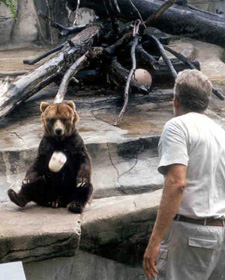When it comes to animal enrichment, nearly every Zoo department gets in on the action.
 Animal Care:
Animal Care: Zookeepers, Animal Care managers,and Curators develop and carry out the enrichment
plans.
Education: The Zoo's librarian helps zookeepers investigating an animal's natural history while Zoo teachers instruct students, on-grounds and through distance learning classes about the importance of enrichment.
Research & Conservation: Zoo scientists help determine if enrichment plans deliver the intended benefits. Researchers analyze activity patterns and collect health and reproductive data to measure results.
Veterinary Care: Veterinarians, as the Zoo's nutritionists, approve any foods used for enrichment purposes. The also help evaluate the safety and appropriateness of other enrichment techniques.
Horticulture: Many Zoo animals chew on "browse"
-fresh branches from trees and shurbs. For example, rhinos are partial to thorny acacia branches. Horticulturists help determine which plants approximate an animal's wild food preferences and help deliver fresh browse to zookeepers.
Maintenance: Some enrichment ideas involve a little construction or heavy lifting. The General Maintenance department offers a hand with building puzzle-feeders, new perching, and even with re-arranging the "furniture" in an exhibit.